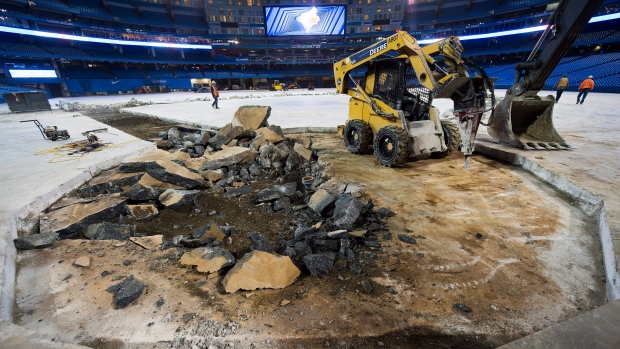Feb 10, 2016
Work begins on Rogers Centre dirt infield
Work began on the Rogers Centre's new all-dirt infield on Wednesday with drills and an excavator breaking up the stadium's concrete floor.
The Canadian Press

TORONTO - Rogers Centre is switching to "baseball mode" permanently.
Work began on the stadium's new all-dirt infield on Wednesday with drills and an excavator breaking up the concrete floor of the Toronto Blue Jays' home. It's the first step in a months-long process that will see Rogers Centre shift its focus into a baseball-first facility.
The switch was made possible after the Toronto Argonauts' lease was not renewed, sending the Canadian Football League team to nearby BMO Field.
"We had that opportunity now where we know we can keep it in baseball mode for the baseball season," said head groundskeeper Tom Farrell as heavy machinery worked behind him on the floor of the stadium. "This was really the only year where we could do this."
The new infield will see a proper dirt diamond connecting home plate to first, second and third base like most other major league ballparks.
Previously, Rogers Centre had squares of dirt around each base and home, with turf between the base paths. When the Blue Jays were on long road trips or the Argos had a game the dirt would be scraped off the cement floor and the pitcher's mound would be lowered in to the ground by hydraulics.
Now the all-dirt infield will be permanent with protective plates laid overtop for other events like concerts or festivals.
Deeper pits for the infield are necessary to increase the circulation of moisture, through two inches of pea gravel, four inches of sand and six inches of clay product, and prevent cracking or dust clouds in the summer heat. The old Rogers Centre infield only allowed four to five inches of dirt.
The new surface could help reduce injuries for infielders and baserunners as the dirt will have more give than the synthetic turf that used to lie between the bases.
"By increasing the depth it does allow us to provide a little bit more of that cushion," said Farrell. "Hopefully there's a side benefit of the players feeling a little bit less fatigue from playing on the newer surface."
Fans taking in Blue Jays games this summer will also notice another difference: the world's fastest groundscrew will be slower and will no longer race in from the outfield.
"It's going to be a learning curve for everybody," said Farrell with a laugh when asked about the groundscrew's record. "There's going to be a new process of doing things, new methods. We'll be using drag equipment which is a lot bigger, so we won't be hauling it from the left-field gate like we have previously."
___
Follow @jchidleyhill on Twitter

